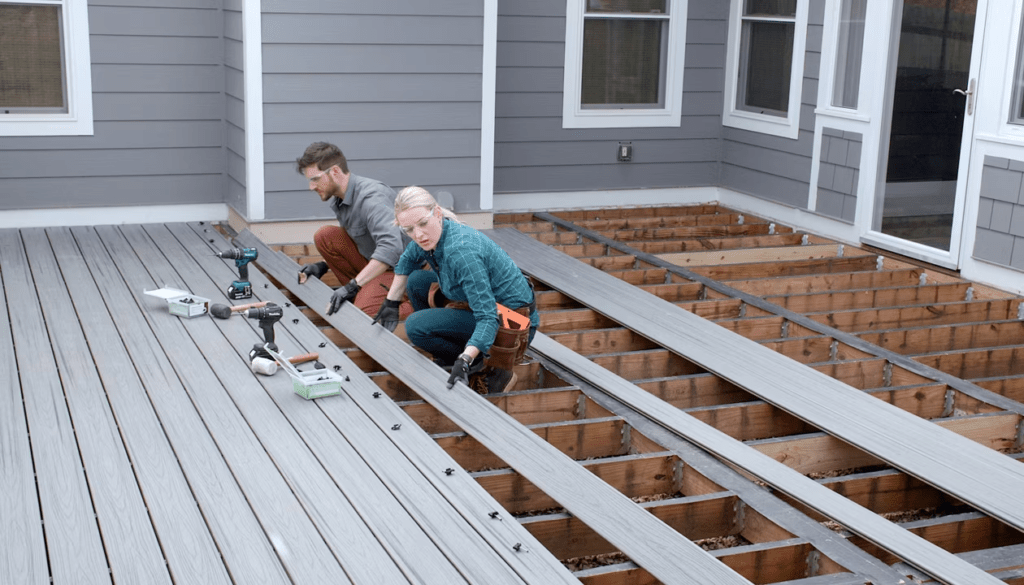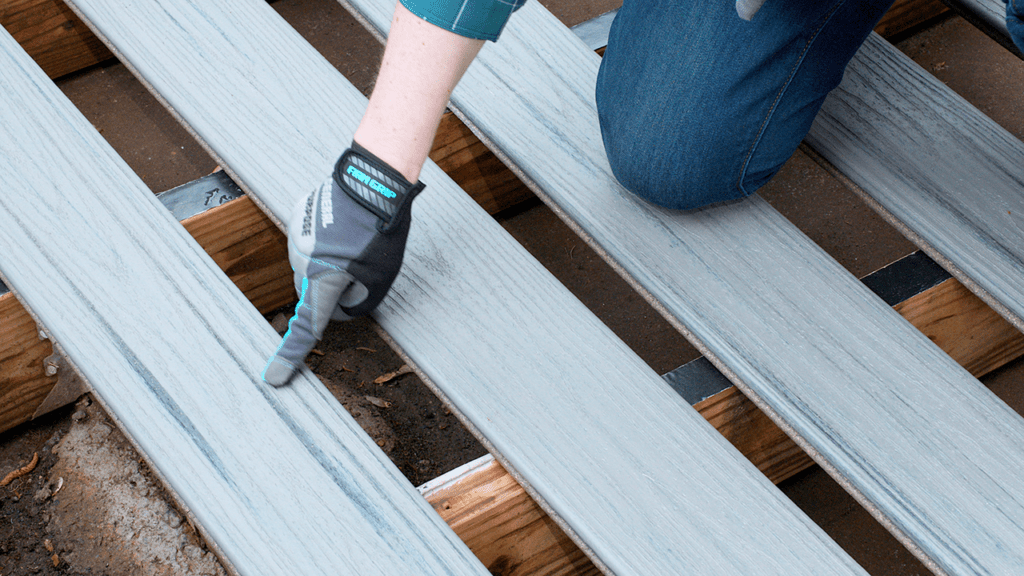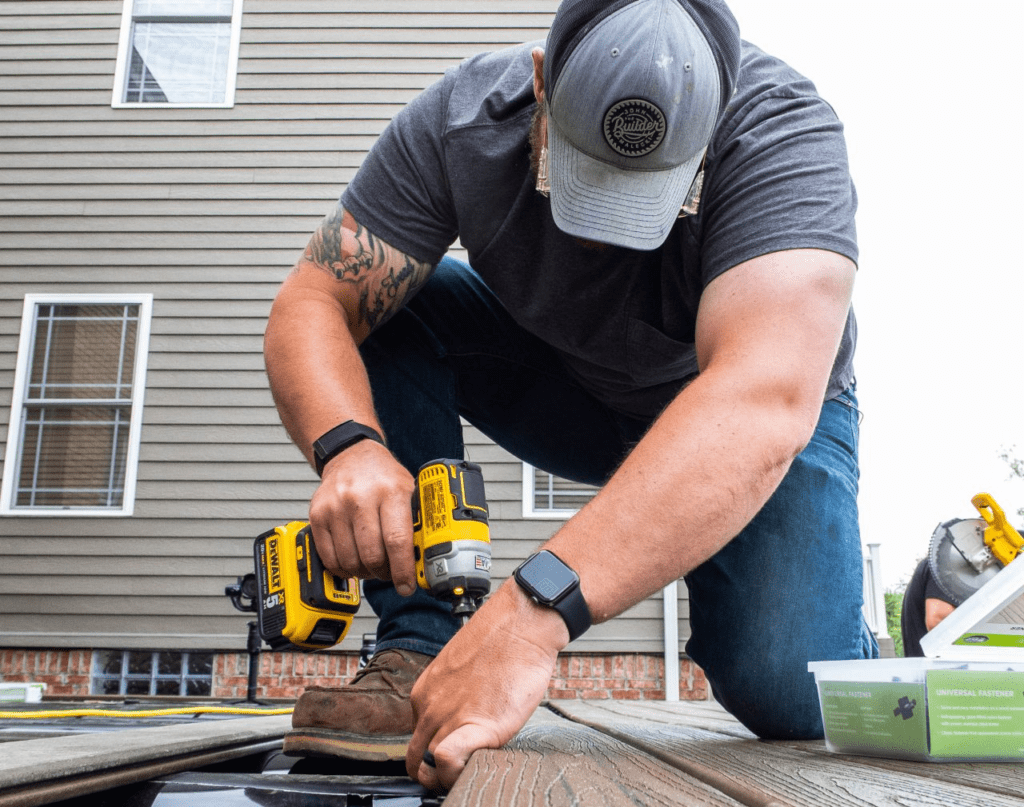Properly spaced Trex deck boards ensure your deck performs well and lasts longer by preventing common issues like water pooling, warping, and debris accumulation.
In this article, we’ll explore the key factors affecting Trex deck board spacing, provide official guidelines from Trex, and offer practical installation tips for a seamless result.
The Importance of Proper Trex Deck Board Spacing
Trex composite decking responds to environmental factors by expanding and contracting, much like other outdoor materials. Improper spacing can lead to buckling, warping, and moisture buildup, which may damage both the deck boards and the substructure over time.
When installing Trex decking, it’s important to consider temperature and humidity. Trex recommends specific gaps based on installation environments to ensure your deck remains in top condition.
Additionally, local building codes may also impact the required spacing and structural supports, so always check with your municipality for specific requirements. This ensures compliance, safety, and long-term durability.
Following the manufacturer’s spacing guidelines ensures both long-term performance and structural integrity.
Official Trex Deck Board Spacing Guidelines

Trex provides specific instructions for the correct gapping of its deck boards, which depend on installation conditions. Following these guidelines ensures that your deck will remain in good condition for many years.
Width-to-Width Gaps
For standard installations, Trex recommends leaving a 3/16-inch (5 mm) gap between the edges of each board. In high-moisture environments, like docks or wooded areas, this gap should increase to 3/8 inches (10 mm) to improve airflow and drainage.
End-to-End Gaps
The gap between the ends of the boards is based on the temperature at installation:
- Above 40°F (4.5°C): Leave a 1/8-inch (3 mm) gap.
- Below 40°F (4.5°C): Increase the gap to 3/16 inches (5 mm).
Gapping at Solid Objects
When decking abuts a wall, post, or other solid objects, a gap of 1/4 inch (6 mm) to 1/2 inch (13 mm) is recommended, depending on the weather conditions during installation. This spacing allows for natural expansion during warmer temperatures.
Understanding the factors that influence deck board spacing is essential for ensuring a smooth installation and the long-term durability of a Trex deck.
Factors That Influence Deck Board Spacing
Several environmental and material factors affect how these gaps are implemented. Consider the following when planning your Trex deck installation:
Climate and Temperature
The climate at the time of installation is a key factor. Warmer temperatures require smaller gaps, while colder environments need larger ones to accommodate contraction. In regions with heavy snowfall or significant rainfall, proper spacing is critical to managing water flow, preventing pooling, and reducing the likelihood of structural damage from moisture accumulation.
Impact of Altitude
For installations at higher altitudes, temperature fluctuations are often more extreme. In areas where daytime temperatures vary greatly from nighttime lows, boards may expand and contract more rapidly. To mitigate this, slightly larger end-to-end gaps may be necessary. These larger gaps will accommodate the sudden shifts in temperature that are common in mountainous regions.
Material Properties
While Trex expands less than wood, wider boards like 2x6s need more space to adjust to temperature shifts, requiring larger gaps than narrower boards. Wider boards tend to expand more, meaning gaps can grow larger than expected if not accounted for properly during installation. Accurate spacing ensures that expansion won’t cause long-term issues like buckling or gaps too large for the deck’s aesthetic.
Importance of Drainage and Airflow
Spacing also impacts the deck’s ability to drain water and promote airflow beneath the surface. Proper drainage is crucial to prevent water from pooling and damaging the deck over time. While Trex composite decking resists water damage, ensuring airflow helps the substructure remain dry, preventing issues like mold or mildew, which can affect the deck’s longevity. Properly spaced boards not only allow water to flow off the surface but also reduce the risk of debris getting trapped between the boards, making maintenance easier.
In addition to performance, proper deck board spacing plays a crucial role in supporting sustainable building practices and reducing the environmental impact of decking projects.
Sustainable Practices and Environmental Impact
Trex decking is made from 95% recycled materials, utilizing reclaimed wood fibers and plastic, which reduces waste going to landfills. By ensuring proper deck board spacing, homeowners contribute to the long-term sustainability of their deck. Proper spacing means fewer repairs and less need for material replacements over time, which aligns with eco-friendly practices. By reducing future resource consumption, a well-maintained Trex deck helps minimize the environmental impact of decking projects.
Maintaining consistent spacing throughout the installation process is key to achieving a professional-looking and durable Trex deck.
Tips for Maintaining Consistent Deck Spacing

Accurate spacing during installation ensures lasting deck performance. Here are a few tips to ensure consistency throughout your project:
Use Trex Hidden Fasteners
Trex’s hidden fastener system maintains the recommended gap between deck boards. The fasteners automatically space the boards by 3/16 inches (5 mm), making it easier for DIYers to ensure proper gapping while achieving a clean, polished look. Hidden fasteners also provide an aesthetic advantage by eliminating visible screws and reducing the risk of corrosion, which can occur over time with exposed fasteners.
Tools and Techniques for Consistency
Using a deck board spacer tool is an effective way to maintain uniform gaps, particularly on large projects. Pre-drilling holes can also help prevent splitting in boards, especially in climates with large temperature fluctuations. When working on long deck installations, string lines or laser levels can help ensure that the deck remains aligned, reducing the risk of uneven gaps across the surface.
Avoiding common mistakes during installation is crucial to ensuring proper deck board spacing and long-term deck performance.
Common Mistakes to Avoid
Some common mistakes include ignoring the temperature during installation or over-tightening fasteners, which can lead to improper gapping. Additionally, failing to account for material expansion in varying climates can result in warping. Always use the proper tools and be mindful of temperature to ensure smooth installation.
Joist Tape for Moisture Protection
To protect the deck’s joists from water damage, consider applying joist tape before installing the deck boards. Joist tape acts as a moisture barrier, sealing around the fasteners and preventing water from penetrating the wood, which can cause it to expand or contract over time. This simple addition can significantly extend the lifespan of your deck structure, particularly in humid or wet environments.
Certain environments may require additional considerations to ensure the longevity and performance of a Trex deck.
Special Considerations for Different Installations

In certain environments, additional measures may be required to ensure the longevity of your Trex deck. Whether you’re installing a deck near water or in high-traffic areas, these factors should be taken into account:
Docks and Marine Applications
For docks or structures near water, Trex advises increasing the width-to-width gap to 3/8 inches (10 mm) to allow for enhanced drainage and airflow. Additionally, use stainless steel fasteners to prevent corrosion, which is common in high-moisture environments. Maintaining a larger gap in marine applications is important, as decks near water are more susceptible to moisture buildup, which can compromise the integrity of the structure over time.
High Traffic or Commercial Use
For decks in high-traffic areas or commercial settings, you may need to reduce the joist spacing for added strength and support. This helps prevent sagging and ensures that the deck can handle heavier loads without compromising its structural integrity. Additionally, maintaining consistent spacing in these areas is important for safety, as improper spacing can lead to trip hazards or uneven surfaces over time.
Proper winterizing of your Trex deck is essential for protecting it from the harsh effects of cold weather and ensuring its durability year-round.
Winterizing Your Trex Deck
In regions that experience harsh winters, it’s essential to winterize your Trex deck properly.
- Ensure that snow and ice are cleared regularly to prevent moisture from freezing between the boards, which can cause warping or damage.
- Using plastic shovels instead of metal will prevent scratches on the deck surface.
- For colder climates, consider slightly increasing the gap between boards to accommodate contraction in freezing temperatures.
Avoid using de-icing chemicals, as they may damage the deck surface. Instead, use sand to improve traction without compromising the deck’s finish.
Choose LumberPlus for Your Trex Decking Needs
LumberPlus is committed to providing high-quality Trex decking materials to ensure your project meets the highest standards. Whether you’re building a residential deck or a large commercial installation, our range of Trex products and expert advice can help you achieve outstanding results.
Contact us today for more information.






